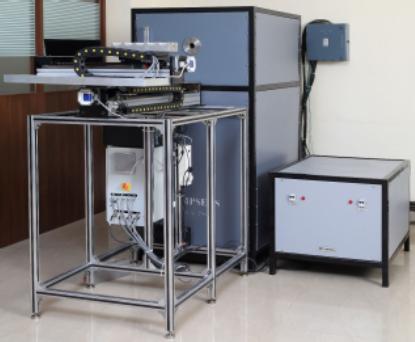Infrared Pyrometer
A pyrometer is a noncontact temperature sensor that infers the temperature of an object by detecting its naturally emitted thermal radiation. Pyrometer comprises of metallic housing inside which Optics, Infrared Detector, Signal Converters and conditioning units, display unit etc.
The optical system collects the visible and infrared energy from an object and focuses it on a detector. The detector converts collected energy into an electrical signal which is converted to usable format and fed to temperature display or control unit.
Pyrometers find applications in areas where contact temperature measurement is not feasible due to moving objects, high temperatures, not easy to access the locations etc.

Pyrometer Calibration
For Pyrometer calibration at Comparison method we have required
- Stable Black Body Furnace
- Calibrated master sensor
The device with the known or assigned correctness is called the standard Sensor and the second device is the unit under Calibration, test instrument, or any of several other names for the device being calibrated.
Emissivity (ε)
Emissivity is the ratio of energy radiated from an object to the exterior and energy radiate from blackbody. The emissivity varies with the surface condition of the object and also with temperature variation and wavelength. If this value is not accurate, then the true temperature cannot be measured. In other words, a variation or change in emissivity will cause a change in the indications.
By the Kirchhoff’s law of thermal radiation “At thermal equilibrium, the emissivity (ε) of a body (or surface) equals its absorptivity (α)”. So, for a perfect black body, ε is 1 while any real object would have ε less than 1. Also the transmissivity (τ) and reflectivity (ρ) is zero.
The sum of absorptive, reflectivity and transmissivity is always 1.
α + ρ + τ = 1.
Find the Effective Emissivity from this formula:
- Effective Emissivity: 1 – (1- Es) * (R/L)2
- Where, Es = Emissivity of Black Body Cavity
- R = Radius of Cavity
- L = Length of Cavity.

Calibration Procedure
- The Pyrometer under calibration is physically checked
- Connect the Black body source to the power supply. Set the black body source at desired temperature
- Set the emissivity of the pyrometer as per Black Body Emissivity.
- When Temperature is stable in black body source within its stability range, take the readings of the standard Pyrometer. Aim of the pyrometer in the center of the cavity so as to get the correct temperature reading.
- Take the standard sensor reading.
- Connect the test pyrometer to suitable power supply and the aim of the pyrometer to the center of cavity of black body.
- Take the readings of test Pyrometer.
- Take the 10 readings of Standard and Test pyrometer in every 1 minute interval.
- The actual temperature of Master Pyrometer is calculated from its calibration certificate.
- Find out the error by comparison method.
- Reset the Black Body Furnace for another point or for another sensor.
Precaution
- The Standard and Test Thermocouple are handled carefully by a well trained Engineer
- Always set Emissivity of Master Sensor and Test Sensor will be set on same.
- Readings are always taken at stable condition of the furnace temperature.
- The HT furnace while operating at high temperature above 400 Deg C, should not be suddenly switched off.
- This may reduce the life of furnace.
- Set the Standard and Test Pyrometer as per its spot to size ratio










